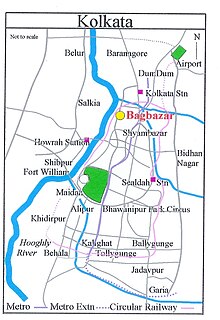Bagbazar
| Bagbazar | |
|---|---|
| Neighbourhood in Kolkata (Calcutta) | |

Bagbazar Ghat on Hooghly River
|
|
 |
|
| Country |
|
| State | West Bengal |
| City | Kolkata |
| Ward |
|
| Metro Station | Shyambazar |
| Parliamentary constituency | Kolkata Uttar |
| Assembly constituency | Shyampukur |
| Elevation | 36 ft (11 m) |
| Population (2001) | |
| • Total | 20,012 |
| Time zone | IST (UTC+5:30) |
| PIN | 700 003 |
| Area code(s) | +91 33 |
Bagbazar (also spelt Baghbazar) (Bengali: বাগ়বাজার) is a neighbourhood in north Kolkata, in the Indian state of West Bengal. The area, under Shyampukur police station of Kolkata Police, has been, along with neighbouring Shyambazar, the citadel of the Bengali aristocracy. Bagbazar has played an active role in growth and development of Kolkata.
The name, Bagbazar, is derived from two words put together from old Bengali literature: "bagh" meaning flower garden and " bazaar" meaning market. So it refers to a place where flowers are abundant.
As Kalikata became settled, Sutanuti was gradually abandoned by the English as a place of residence. There remained, near its northernmost corner, Perin’s Garden, a pleasure resort, where once it was the height of gentility for the British East India Company’s covenanted servants to take their ladies for an evening stroll or moonlight fete. However, it was little frequented from around 1746 and by 1752 was sold for Rs. 25,000. Captain Perin was owner of several ships. In 1754, Colonel C.F. Scott began manufacturing gunpowder at the garden.
The history of Baghbazar Sarbojanin Durgotsav & Exhibition is an inseparable part of the history and progress of Bengali culture for near about a century it has seen all the transitions and critical periods of history during this long enriched span of time.
We can divide this glorious history in two very distinguished parts; the first period is from 1919 to 1930 and 1930 onwards. This was the first Puja of Calcutta organised by people communally and not inside a Zamindar home. In 1919 first time it was celebrated by the people of Bagbazar at the home of the Sarkars, on Baghbazar Street at the junction of Nebubagan Lane and Bagbazar Street where it had been held privately by the Sarkars for years before, until they couldn't afford to organise it any more. Members of the Public contributed money and continued the Puja and it was named as "Lebubagan Baroyari Durga-puja". It was continued in that very place for more three more years before being shifted in 1924 to the junction of Bagbazar Street and Pashupati Bose Lane. Next year it was placed at Kantapukur and in 1927 it tookplace in the Bagbazar Kali-temple.
...
Wikipedia
